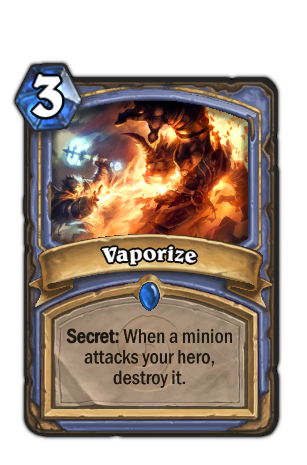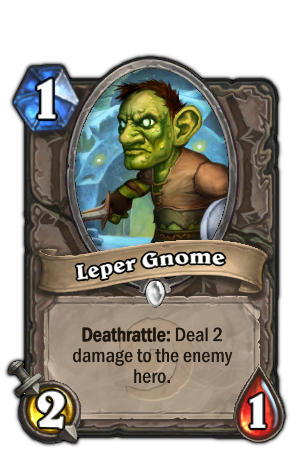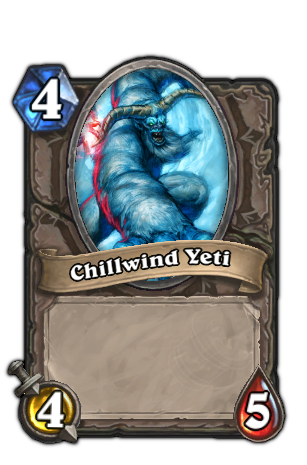Why Hearthstone Matters: A Primer
Hearthstone is having its first tournament this weekend--here's a primer with everything you need to know about the game before you watch as well as why it's worth it.
This article was originally published on GameSpot's sister site onGamers.com, which was dedicated to esports coverage.
Hearthstone took the gaming world by surprise.
When it was first announced at PAX East this year, people were disappointed Blizzard's big announcement was just a card game. Fast forward to this Fall, however, and it's the only thing gamers are talking about. Hearthstone quickly became one of the most popular games on the internet and a robust community sprouted up overnight. And, perhaps in the most surprising news, Razer even signed a professional Hearthstone player this October.
Hearthstone is big--and it's only going to get bigger if its juggernaut of a beta so far has been any indication.
This weekend is Hearthstone's biggest moment so far. Hearthstone and its community will finally see if the game has what it takes to be an esport with its first official tournament. For a game Blizzard pitched as a casual card game, it's taking on quite the life of its own.
So let's take a trip down to valuetown and see what Hearthstone is all about as well as what to watch out for this weekend in the competitive meta.
How to Play Hearthstone
Hearthstone isn't Magic the Gathering.
If you've ever played any trading card game before, throw your preconceptions out the window--with the exception of mana, a resource used to play cards that you gain one of each turn, there's very little in common between the two games. Unlike MtG and other trading card games where overly complex rulesets hurt it as a spectator sport by creating a huge barrier of entry, Hearthstone has largely embraced its simplicity.
In short, Hearthstone succeeds because it’s so easy to get into.
In Hearthstone, every player chooses a class represented by an iconic hero from the Warcraft series. Each class has unique class cards and a hero ability that costs 2 mana to play. For example, Priests heal themselves or a minion for two health making them prone to turtling while Hunters do two damage to their opponents making them extremely aggressive.
After choosing a class, players then construct a deck. Decks can have thirty cards and up to two each of the same card excluding legendaries. There are five qualities of cards: common, uncommon, rares, epics, and legendaries. While it would seem implied that epics would always be better than rares because they're a higher quality, power rankings aren't very linear in Hearthstone.
When constructing a deck, players have four general types of cards to add to it: secrets, minions, weapons, and spells.

Minions are creatures that are summoned into play; they have a mana cost in the upper left and health on the lower right. Minions do not heal after taking damage and will die once their health reaches zero.
Weapons are only available to certain classes: Rogue, Paladin, Shaman, and Warrior. They allow the hero themselves to attack minions and other heroes which is very strong.
Spells can do a myriad of things from buff your own minions to do damage to every minion on the board. They can even be used to nuke enemy heroes. There are dozens of spells and each class has their own specific set.
Secrets are a unique category of spells complex enough to be worth bringing up. They are a spell cast on the hero that is unknown to the opponent until they trigger it by activating one of its conditions. For example, Vaporize is a mage secret that is triggered when an enemy minion attacks your hero--instead of doing any damage, the minion is instantly killed.
These cards can also have a wide range of effects. Taunt cards must be removed or killed before an enemy can damage your hero; cards with battlecries have a unique effect that is triggered only one time when the card is played; cards with charge can attack on the same turn; cards with a death rattle have a unique effect on death; and cards with divine shield are immune to damage.
After constructing a deck from these cards, each player is given a preview of their first selections and given a chance to throw them as many as they want back for one more chance at a draw. A solid starting hand is one that has a fairly wide range of mana costs; you wouldn't want a card like Ysera because while she's very powerful, you would have to wait way too many turns to play her and would lose very quickly.
As a general tenant, you want to aim for an opening hand that has a card to play every turn after the first and settle for anything below four mana cost, mulliganing high cost cards immediately.
This is where luck can come into play. If you draw cards that were all over four mana cost, threw them back, and then got a new hand of similar value, your opening hand is a nightmare to play. Likewise, if you draw all low strength cards, your opening is very easy.
While this doesn't happen a lot, it’s why crafting a deck while paying attention to your mana have matters a lot--if you only have high value cards, you'll find yourself constantly having bad opening hands that don't have enough of an impact in the early game.
Once your opening hand is settled, the game begins. Players always start with thirty health and the game ends once one hero reaches zero health. Players can only play cards and use abilities during their turn.
A Glossary of Terms
We've covered the extreme basics--and you probably knew most of them. So let's define terms you'll be hearing during the tournament weekend from shoutcasters.
Mulligan: The act of throwing back your starting hand's cards for new ones. You can only do this once per match in Hearthstone.
Coin, on the coin, etc.: Unique to Hearthstone is The Coin. The player that goes second in a game receives it to help make up for not being able to play first. Using it right is pretty powerful--it can be saved indefinitely, so a lot of strategy can be used with it.
Removal: Removal are spells that can be utilized to get rid of an enemy threat. For example, one of the best removal cards in the game is Flamestrike which Jaina has. At a cost of seven mana, it deals four damage to every enemy minion on the game; it's absolutely brutal. Other good forms of removal include Polymorph and Swipe.

Trade: The act of killing a card with another card. For example, if you have a Leper Gnome out and they have a Faerie Dragon, you can send your gnome on your turn into the dragon trading it. Trades are where a lot of the skill of the game comes from; knowing when a trade is good or bad is very valuable. Trading a drops like the aforementioned play would be an extremely positive trade due to the fact that the gnome is a weaker card (2/1 compared to 3/2), cost less to play (1 mana vs. 2 mana), and has an ability upon dying that benefits its owner.
Value: Value is what makes the game work. Value can be referring to many things like a good trade or play. Sometimes cards are particularly valuable. Argent Commander is a very high value card because it has divine shield and charge effects meaning when it is played, it can immediately attack an enemy minion and take zero damage--it can remove a card for free! Even if it dies the next turn to another minion or is hit with a removal spell, it had a lot of value since it used two cards for one card.
Two for one: When a player uses more than one ability or minion to remove a card. Let's say that you played Venture Co. Mercenary. It's a huge threat so your opponent must remove it at once. Maybe they remove it using a Frostbolt and by throwing their Mind Control Tech into it--that's a two for one, since they just used two cards to remove one card. You want to avoid two for ones as much as possible while pressuring your opponent into these unfavorable exchanges.
Mana curve: What your deck costs overall. For example, you want to have a balanced mana curve with cards to play at every cost. That way you aren't stuck on turn three without a single card that costs three mana and you don't have to pass the turn, wasting a play entirely and losing speed to your opponent.
Board control and board presence: The concept of “board control” means you have more minions on the board than your opponent. It also ties in well with board clearing, the act of either using a spell or trading all your minions to reset the board so that your opponent doesn't have a lot of creatures out. Clearing the board and having board control is one of the easiest ways to win. There are many classes who have seeming harmless cards--ones with one attack or so--that can buff them instantly in a turn and turn them into killing machines. A great example would be Shaman who have the card Bloodlust.
Because of this, clearing the board is almost a number one priority unless you're able to get an opponent near death.
Cycling: A card that cycles is a card that replaces itself. Cards like Novice Engineer do this instantly by having a battle cry that draws a card. Even if it gets removed, it has already replaced itself in your hand by drawing another card, so it's not a huge problem. Cycling is very valuable for keeping card advantage.
Card advantage: One of the most important ways to win is having more cards than your opponent in your hand. You will almost always win if you have more cards than them because you will have more plays to make each turn. This makes cards such as Divine Favor important; if you are doing favorable trades and making them two for one your cards, you will have a natural card advantage and a bigger board presence. Cards that draw cards just make your chances of winning grow even further.
Competitive Hearthstone

When you're playing Hearthstone more seriously, there are a few things that really matter that may not come up as much while playing casually.
For starters, mana curve is essential in competitive Hearthstone. These players will have constructed decks with balanced curves. They'll have a wide range of mana costs in their game so that they have a balanced early to late game; it's important to average it so your deck doesn't cost too little or cost too much. This means they won't have more than a few legendaries because too many legendaries means the game would stall out and they would stand a chance of losing before they could even play them. Likewise, they aren't going to have a bunch of two drops--unless they're trolling around, which is entirely possible!
Secondly, removal is really strong in Hearthstone's current meta. If players want to win, they're going to be looking to stack maximum removal and silences. Each class has removal cards, but mage, druid, and paladin are the best at it. Expect to see cards like Blizzard and Consecration all the time. Look out for Spellbreaker too.
Card advantage is also a big way to win in Hearthstone. If you have card advantage, you're increasing the speed of the game--you'll have more to play than your opponent. This means cards that draw cards or give cards are king to these players. You'll see them play Azure Drake over Ogre Magi, for example, because it draws a card while giving the same stats otherwise.
Another thing to remember is that competitive players value cards way differently. The meta has an interesting take on the value of cards right now. Cards like Chillwind Yeti might seem bad to an average player because it's just a common, but it's actually one of the best cards in the game according to higher tier players.
There's also a possibility gimmicks will happen. Constructed's current metagame has a lot of cheese at the moment. There have been decks like spell power rogue deck that are extremely strong; there's also downright aggravating decks like an Unleash the Hounds deck where low level minions zerg players down.
Why it Matters
For years, esports has been a fledgling arena limited to specific genres and intense competitions. With the the recent rise of MOBA titles like League of Legends and Dota 2 over the past five years, esports has grown tremendously--but it still has room to grow. It still has new audiences to find. It still has new stories to tell.
That’s where Hearthstone comes in. A new genre comes with Hearthstone and it’s significantly more casual friendly than most games with a wide range of players. From competitive Counter-strike players to StarCraft 2 professionals, nearly everyone is giving Hearthstone a try and enjoying it.
Ultimately, Hearthstone could be esports’ answer to reaching even more people around the world. Easily watchable with a low barrier of entry, Hearthstone reaches everyone from the extremely casual to the intensely hardcore--and isn’t that what we have all been looking for this past decade? An esport to bridge the gap?
Got a news tip or want to contact us directly? Email news@gamespot.com
Join the conversation